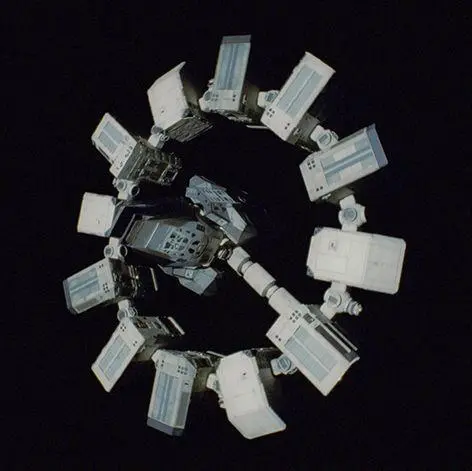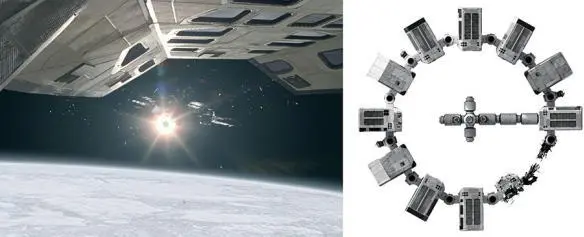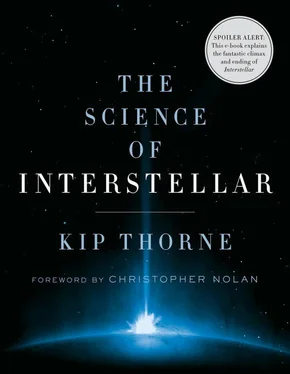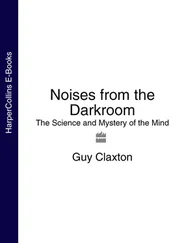

Fig. 19.3. Top: Romilly (played by David Oyelowo) and Brand (played by Anne Hathaway) discuss Dr. Mann’s geological data with him. Bottom: One page of data, prepared for the movie by Erika Swanson: the results of chemical analyses of rocks collected on the purported surface of the planet. Several rocks show promising evidence of organic material that could have arisen from living things. [From Interstellar , used courtesy of Warner Bros. Entertainment Inc.]
In the movie, it turns out that Dr. Mann has faked his data. That’s a bit ironic since, of course, Erika faked her data too. She has never made a field trip to Mann’s planet. Perhaps someday…
In this book I say nothing about the tragedy of Dr. Mann. It’s a human tragedy, involving little science. The tragedy’s climax is an explosion that severely damages the Endurance . The explosion, the damage, and the Endurance ’s design: that’s the stuff of science and engineering, so let’s discuss them.
20
The Endurance

Tidal Gravity and the Endurance ’s Design
The Endurance has twelve modules linked in a ring, and a control module at the ring’s center (Figure 20.1). Two landers and Rangers dock onto the Endurance ’s central module.

Fig. 20.1. The Endurance , with two Rangers and two landers docked onto its central, control module. The Rangers are oriented out of the Endurance ’s ring plane; the landers, parallel to it. [From Interstellar , used courtesy of Warner Bros. Entertainment Inc.]
In my scientist’s interpretation of the movie, the Endurance was designed to survive strong tidal gravitational forces. This was important for the Endurance ’s trip through the wormhole. The Endurance ring’s diameter of 64 meters is nearly 1 percent of the wormhole’s circumference. Steel and other solid materials break or flow, when subjected to distortions bigger than about a few tenths of a percent, so the dangers were obvious. And little was known about what the Endurance would encounter on the Gargantua side of the wormhole, so it was designed to withstand tidal forces far stronger than the wormhole’s.
Now, a thin fiber can be bent around into complicated shapes without any portion of the fiber’s material being distorted by anything close to 1 percent. The key is the thinness of the fiber. You could imagine the Endurance ’s strength relying on a huge number of thin fibers stretching around the ring, like the strands of a cable that hold up a suspension bridge and can bend as needed when a strong wind blows. But that would make the ring too flexible. The ring needs much resistance to being deformed, so it won’t deform so severely, when subjected to tidal forces, that the modules crash into each other.
The designers, in my interpretation, worked hard to make the Endurance resist deformation but be able to deform without breaking if it encounters tidal forces far stronger than anticipated.
Explosion in Orbit Above Mann’s Planet
This design philosophy really pays off when Dr. Mann unwittingly triggers a huge explosion that breaks the Endurance ’s ring, destroys two of the ring modules, and damages two others (Figure 20.2).

Fig. 20.2. Left : The explosion on the Endurance , with the lander above and Mann’s planet below. (The ten radial light beams are lens flare due to scattering of light in the camera lens, not stuff from the explosion.) Right : The damaged Endurance after the explosion. [From Interstellar , used courtesy of Warner Bros. Entertainment Inc.]
The explosion sets the ring spinning so fast that its modules feel 70 gees (70 Earth gravities) of centrifugal force. Its broken ends swing apart from each other but don’t break, and the ring’s modules don’t crash into each other. This, in my scientist’s interpretation, is a great example of conservative design by clever engineers!
Incidentally, I’m impressed by the explosion in the movie. An explosion in space makes no sound, as there is no air to transmit the sound waves. The Endurance explosion has no sound. The flames in such an explosion must quench quickly, as the oxygen that feeds them is quickly disbursed into space. The flames in the movie quench quickly. Paul Franklin tells me that his team worked hard to achieve this, as the explosion was a real one, on a movie set, and not a computer-generated visual effect. Another example of Christopher Nolan’s commitment to science accuracy.
Our discussion of Gargantua’s environs has taken us from the physics of planets (tidal deformation, tsunamis, tidal bores, …), through Gargantua’s vibrations and the search for organic signs of life, to engineering issues (the Endurance ’s robust design and its damaging explosion). As much as I enjoy these topics—and I’ve done research or textbook writing on most of them—they are not my greatest passion. My passion is extreme physics; physics at the edge of human knowledge and just beyond. That’s where I take us next.
21
The Fourth and Fifth Dimensions
Time as the Fourth Dimension

In our universe, space has three dimensions: up-down, east-west, and north-south. But to schedule lunch with a friend, we must tell her not only where, but also when . In this sense, time is a fourth dimension.
However, time is a different kind of dimension than space. We have no trouble traveling westward as well as eastward; we make our choice and go. But having arrived at our luncheon, we cannot immediately, then and there, travel backward in time. No matter how hard we may try, we can only travel forward. The relativistic laws guarantee it. They enforce it. [34] But the relativistic laws do offer the possibility of backward time travel by a circuitous route: going outward in space and returning before we left. To this I return in Chapter 30.
Nevertheless, time is a fourth dimension; it is the fourth dimension of our universe. The arena for our lives is four-dimensional spacetime, three space dimensions plus one time dimension.
When we physicists explore this spacetime arena by experiments and by mathematics, we discover that space and time are unified in several ways. At the simplest level, when we look out in space, we are automatically looking backward in time because of how long it takes light to reach us. We see a quasar a billion light-years away as it was a billion years ago, when the light that enters our telescope was launched on its journey to us.
At a much deeper level, if you move relative to me at high speed, then we disagree on what events are simultaneous. You may think that two explosions, one on the Sun and the other on Earth are simultaneous, while I think the Earth explosion was five minutes before the one on the Sun. In this sense, what you regard as purely spatial (the separation of the explosions) I see as a mixture of space and time.
Читать дальше

















